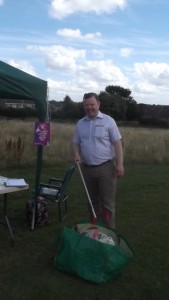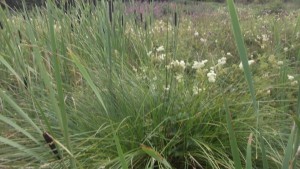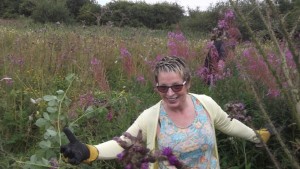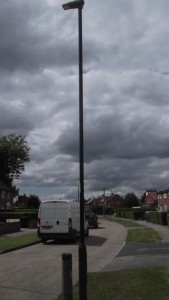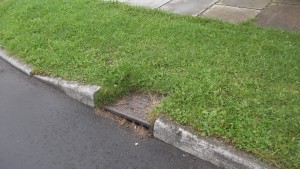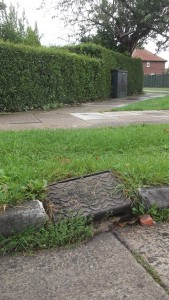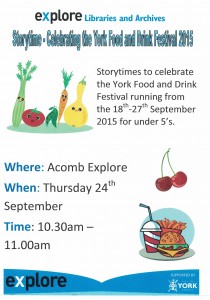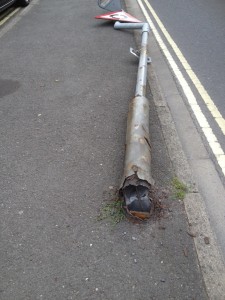Westfield Fen and Bachelor Hill field in the spotlight
There have been some recent works to help local habitats in Westfield. This has been coordinated by Margaret Trigg who is working as a trainee with the council being funded by the Heritage Lottery Fund as part of the Natural Network Programme which runs for 12 months.
In Westfield Ward – Westfield Fen (in the area often called the ‘Mud hills’ in the path between Grange Lane and Westfield Place ) and Bachelor Hill field are areas where specialist habitat produces habitat for rare species such as Trussock Grass https://en.wikipedia.org/wiki/Tussock_(grass)
On 13th August there was a session to control the vegetation (Willow and Willow Herb) which if left unchecked would dry the marsh out. Andrew and Sue went along to lend a hand to the Conservation Trust Volunteers.
The survey done by the council found that there were residents who were interested in getting involved with wildlife habitats – although there was an acceptance that the lack of prior consultation with residents about the project on Bachelor Hill field had been a poor start for the work done on habitats there under the previous council administration.
Some residents have been concerned about so much of the field (previously grassland) had been given up to large earthworks and long grass. Therefore below is the information sheet to answer some questions.
- Why was the new area of grassland created?
The new area of wildflower grassland at Bachelor Hill was created in 2012 to mitigate for the loss of a Site of Importance for Nature Conservation (SINC) from a development site on York Business Park.
In 2011 Ideal Care Homes made an application for planning permission to build a private 64 bed care home for older people on land at York Business Park (Great North Way). This application was refused by City of York Council (CYC) principally on the issue of unacceptable loss of employment land, but also regarding the loss of the SINC. The applicant appealed to the Planning Inspectorate against this decision, which was overturned and permission was granted in April 2012.
A condition of the approved planning permission was to relocate the SINC to mitigate for the loss of biodiversity on the development site and as an opportunity to enhance biodiversity in another area of York.
- What is a Site of Importance for Nature Conservation?
Sites of Importance for Nature Conservation (SINC) are local, non-statutory designations. Whilst they have no direct legal protection, SINCs are considered important enough to receive protection through the planning system. National planning policy requires local authorities to identify and provide for their protection through local policy. In the City of York area there are 86 sites identified as fulfilling the requirement for designation as a SINC. These sites have been assessed against a robust set of guidelines developed in partnership across North Yorkshire by local authorities, ecologists and local nature experts.
SINCs provide a network of thousands of areas of natural habitat across the country providing space for wildlife, and people. They also provide some of the natural services we rely on to maintain a healthy and sustainable environment; such as clean air and water, pollinators and food production, and flood resilience.
- Why was the grassland from York Business Park moved to Bachelor Hill and not somewhere else?
Bachelor Hill was chosen as the place to move the grassland to because of the type of soil and conditions found here.
Bachelor Hill is a prominent morainic (formed by glaciers) sandy knoll. The area of open sand on the site, known as the ‘sandpit’ is possibly unique for York, a remnant of the previously much more extensive dry sandy habitat that once characterised the Acomb area.
This type of soil was suitable for the species found on the site at York Business Park.
- Why wasn’t it put over the ‘sandpit’ area or around the edges of Bachelor Hill?
The ‘sandpit’ area and edges of the field are an existing SINC with its own interest of plants and invertebrates.
Dog walkers like to use the edge of the field as a circular route and so this was left clear. The Public Right of Way on the site runs through the centre connecting the entrances at Askham Lane and Tennant Road, and it was made sure that this was also left clear.
- There looks like a lot of stone and rubbish in the soil, why is this?
The grassland at York Business Park developed on ballast that had been left there when a previous development did not go ahead.
To give the translocated plants as best chance as possible the ground at Bachelor Hill was prepared by stripping away the existing top soil and mixing in new Limestone chippings. Amenity grassland (grass that is regularly mown short) normally has too many nutrients in the soil for wildflowers to be successful; more dominant species like nettles and docks prefer these conditions.
Top soil was then moved from York Business Park to Bachelor Hill to ensure roots and the existing seed bank in the soil was kept.
- The grassland looks long and dead, why hasn’t it been cut yet?
Management of wildflower grassland involves allowing the plants to naturally grow, flower, and set seed in the summer. The grassland is then cut in late summer and the plants are left to re-grow again. The tall vegetation also provides shelter and habitat for invertebrates and small mammals, which in turn benefits birds and animals such as bats.
Some areas, such as the sandy and stoney parts, aren’t regularly cut but allowed to regenerate naturally. This provides greater diversity in habitats on the site.
- Why are there lots of bare patches?
Bare areas of earth and exposed sand have been created on purpose to compliment the ‘sandpit’ area on Bachelor Hill. Bare earth is an important habitat in itself particularly for invertebrates and a variety of habitat on a site increases its value for wildlife.
In 2004 an invertebrate survey of Bachelor Hill produced some surprising and remarkable records for sandy and heathy habitats. This included a number of flies that are characteristic of coastal dunes. As such Bachelor Hill is extremely important within the region for its invertebrate interest.
- Who paid for the work to be done?
All of the site preparation, moving of soil and plants, and additional planting was paid for by the developer of the care home as part of the condition for planning permission.
- How will this area of wildflower grassland be managed in the future?
Part of the grassland will be cut once each year in late July – September. After cutting, the clippings will be raked off and removed. If left on, they can smother delicate plants, and increase fertility which encourages rank growth at the expense of wildflowers. In previous years we have worked with a charity called The Conservation Volunteers to do this.
Other areas of Bachelor Hill will continue to be mown short as amenity grassland.
- How can I get involved with looking after the site?
Working in partnership with The Conservation Volunteers we recently undertook a consultation on a number of green spaces in York to find out how people used them, what they valued most, and how they thought the sites could be improved.
For a number of years a group of local people called Friends of Bachelor Hill have worked hard to care for the site including regularly picking litter to keep it looking good for everyone to enjoy.
Working with this group, it is planned to explore how we can further enhance this site for people and for wildlife. The results of the survey made it clear that there are many local people who value this site and within the survey responses, people set out some useful and imaginative suggestions as to how Bachelor Hill could be improved.
A meeting is being organised, together with the Friends group, of all those who care about and are impacted by what happens at this site to start making plans for its future.
If you have supplied your email address within the survey you will be hearing about the meeting soon. If not please contact Margaret Trigg on Margaret.trigg@york.gov.uk and she will ensure that you are kept informed.
|
FOR MORE INFORMATION
We hope this answers the questions you may have about the grassland translocation from York Business Park to Bachelor Hill but if you have any more please contact Nadine Rolls, Countryside & Ecology Officer at City of York Council.
Email: nadine.rolls@york.gov.uk Tel: 01904 551 662
|

